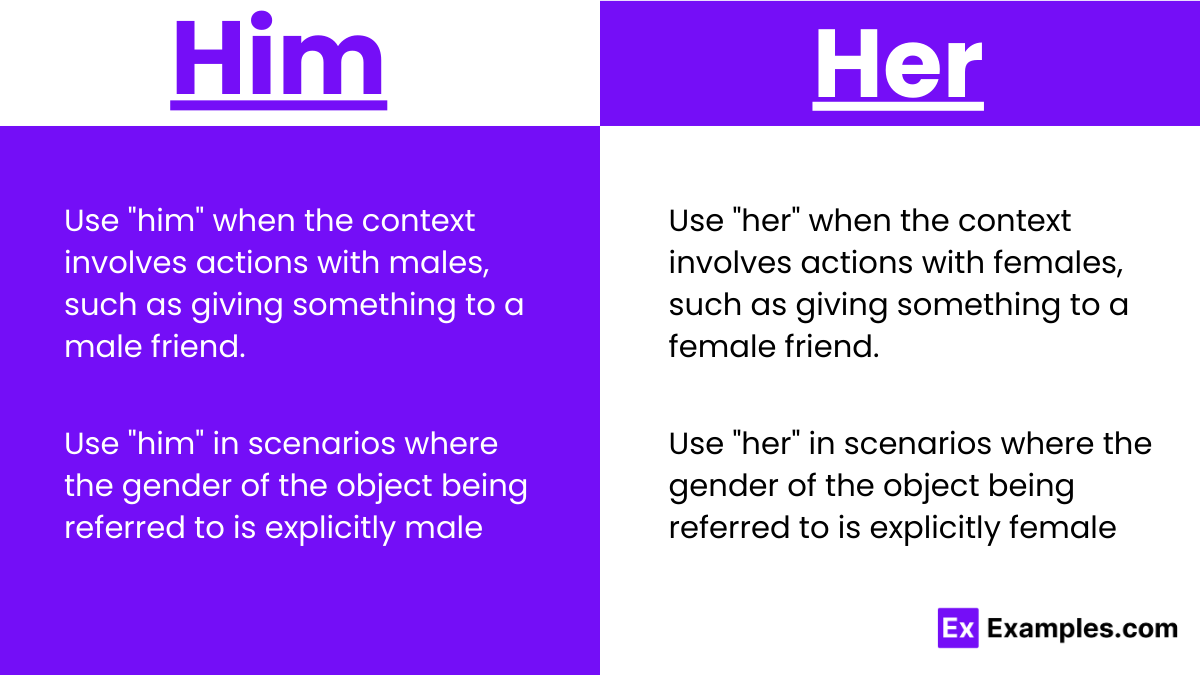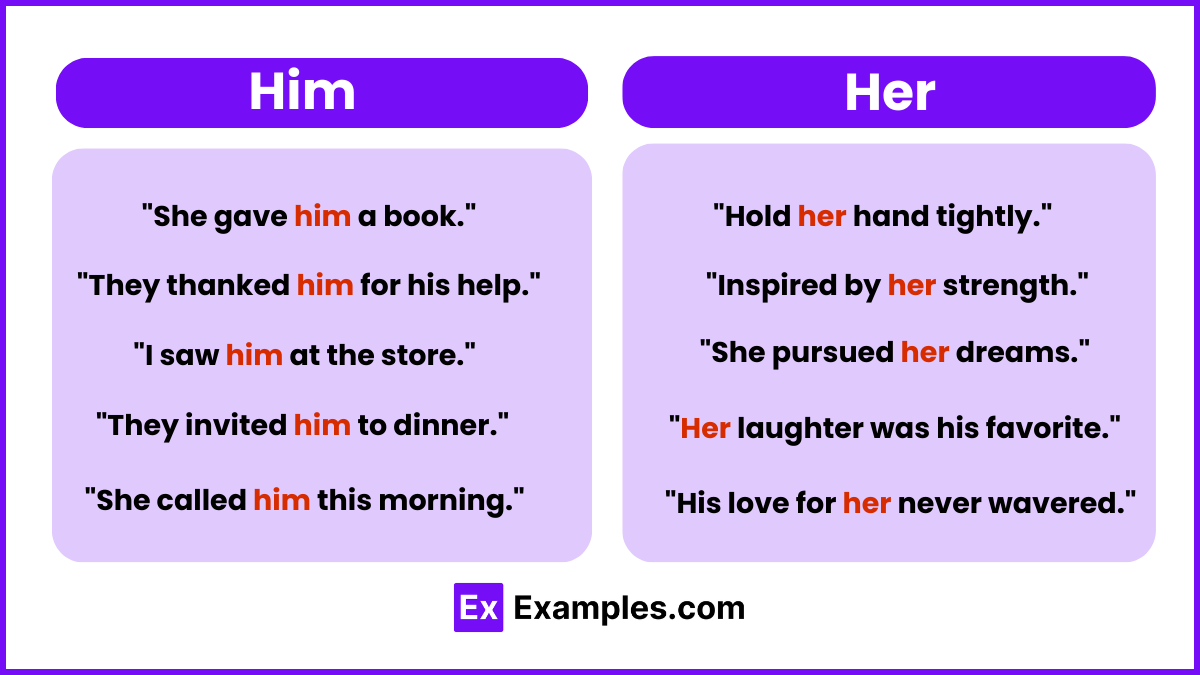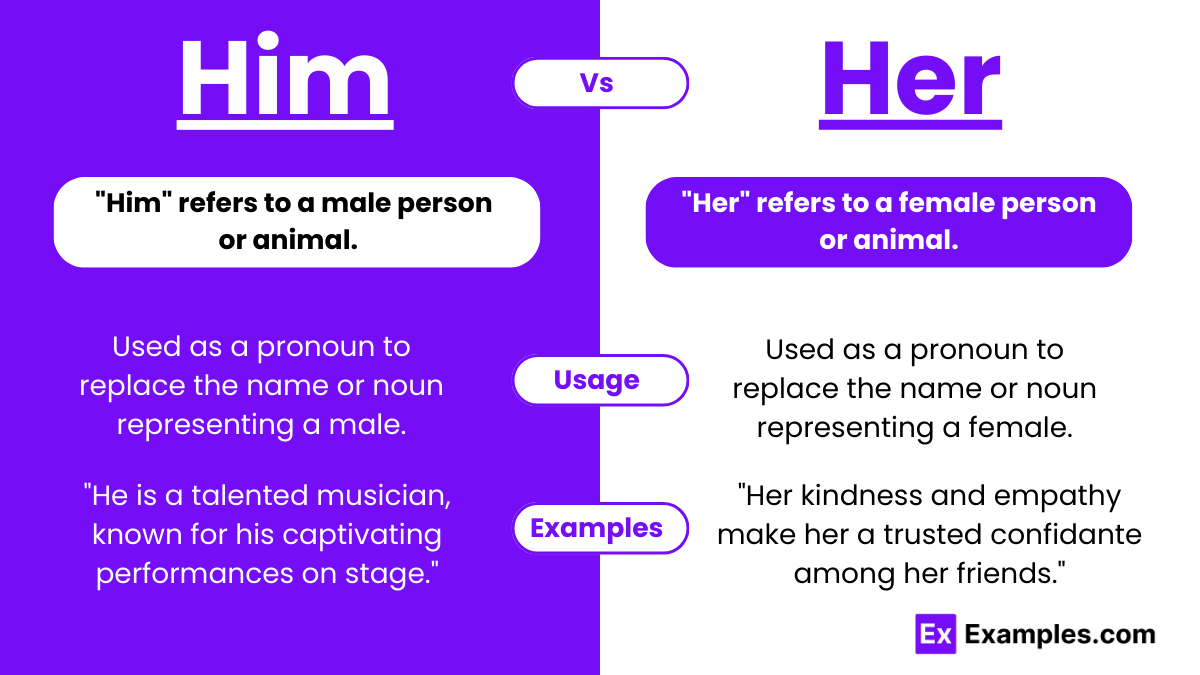Him vs Her – Meanings, Difference, Examples, Usage
When learning English, grasping the distinctions between pronouns like “him” and “her” is crucial. These pronouns are commonly used and play a fundamental role in English grammar. “Him” typically refers to a male person or object, while “her” is used to refer to a female person or object. To ensure accurate usage, it’s essential to understand the nuances between “him” and “her.”
Him and Her – Meanings
“Him” and “her” are both pronouns used to refer to specific genders, but they are used differently.
- Him: Refers to a male person or animal. Used as a pronoun to replace the name or noun representing a male. Helps in avoiding repetition and making sentences concise when talking about males.
- Her: Refers to a female person or animal. Used as a pronoun to replace the name or noun representing a female. Facilitates clearer communication and avoids redundancy in sentences concerning females.
Summary
“Him” and “her” are simple English words used to refer to people, specifically males and females. To avoid confusion, remember that “him” is used when talking about a male, and “her” is used when referring to a female. For example, if you’re talking about giving something to a male, you would say “Give it to him.” If you’re referring to giving something to a female, you would say “Give it to her.” Just remember, “him” for males, and “her” for females, and you’ll use these words correctly.
How to Pronounce Him and Her
- Him: Pronounced as /hɪm/ (HIM).
- Her: Pronounced as /hɜːr/ (HER).
Differences between Him and Her
| Aspect | Him | Her |
|---|---|---|
| Gender | Refers to males | Refers to females |
| Function | Represents masculine objects | Represents feminine objects |
| Usage | Used for male subjects | Used for female subjects |
| Formality | Casual | Casual |
| Frequency | Common in everyday language | Common in everyday language |
How to Remember the Difference between Him and Her
- Think of “him” as referring to males or boys. It contains the word “him,” which starts with “h” just like “he” does, indicating masculinity.
- “Her” indicates females or girls. It contains the word “her,” which starts with “h” just like “she” does, indicating femininity.
When to use Him and Her

Usage of Him
- Use “him” when the context involves actions or interactions with males, such as giving something to a male friend or talking about a male colleague.
- Use “him” in scenarios where the gender of the object being referred to is explicitly male, based on the context of the conversation or text.
- Use “him” when responding to questions or statements that involve males, ensuring grammatical correctness and clarity in communication.
Usage of Her
- Use “her” when the context involves actions or interactions with females, such as giving something to a female friend or talking about a female colleague.
- Use “her” in scenarios where the gender of the object being referred to is explicitly female, based on the context of the conversation or text.
- Use “her” when responding to questions or statements that involve females, ensuring grammatical correctness and clarity in communication.
Him and Her – Examples

Him:
- They admired him for his talent.
- She kissed him goodbye.
- We visited him last week.
- They asked him for advice.
- She trusted him with her secret.
Her:
- She is a passionate advocate for social justice, tirelessly working to create positive change in her community.
- Her creativity knows no bounds, as she continually surprises others with her innovative ideas.
- She finds solace in painting, using colors to express her emotions and inner thoughts.
- Her kindness and empathy make her a trusted confidante among her friends.
- Despite setbacks, she approaches her life with optimism and a determination to succeed.
Synonyms
| Him | Her |
|---|---|
| He | She |
| Mr. | Mrs. |
| Gentleman | Lady |
| Guy | Gal |
| Man | Woman |
Exercise
- They gave the award to __________.
- She invited __________ to the party.
- __________ asked __________ to return the book.
- He offered __________ his seat on the bus.
- __________ will be joining us for dinner tonight.
Answers
- him
- her
- She, her
- him
- She
FAQ’S
What is the difference between him and his?
“Him” is an object pronoun, while “his” is a possessive pronoun. “Him” refers to a male object, while “his” denotes possession by a male.
Can We Use Him for Female?
No, “him” is specifically for males. Use “her” for females.
Where Do You Use Him?
Use “him” as an object pronoun for males in sentences, after prepositions like “with him” or “to him,” or when referring to male individuals.
Is “It’s Him” Grammatically Correct?
Yes, “it’s him” is grammatically correct when referring to a male object.
How Can I Use Him in a Sentence?
Use “him” to refer to a male object receiving action in a sentence or after prepositions like “for him” or “with him.”
Is “Him” Grammatically Correct?
Yes, “him” is grammatically correct as an object pronoun for males in English sentences.


